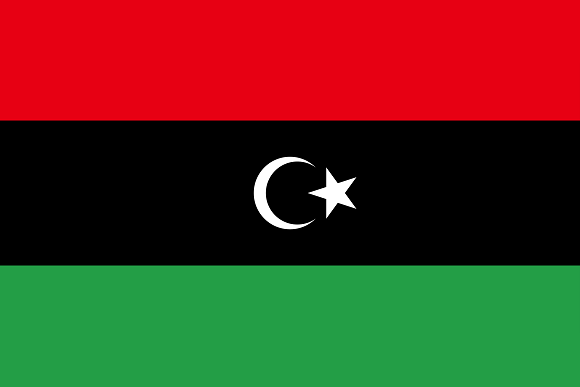
Geography

Source: This image is the intellectual property of Rei-artur. Redistribution under licence CC BY-SA 3.0
Area: 1,760,000 km2 (0% water)
Coastline: 1,770 km
Terrain: Mainly barren soil, consisting of plains, plateaus and depressions. The biggest part of the country is a desert. Mountains are located in the southeast, northeast, northwest and west part of Libya
Highest point: Bikku Bitti 2,267 m (in southeast Libya, on the Chad border)
Climaste: Mediterranean climate on the coast, desert climate in the interior
Geographical population distribution: The population is concentrated in norther Libya, mainly in cities to the west and east of the Gulf of Sidra. About 30% of the population resides in Tripoli and Benghazi
Natural resources: petroleum, natural gas, gypsum
- Ages 0–14: 28%
- Ages 15–64: 68%
- Ages 65+: 5%
- Men: 70.27 years
- Women: 76.11 years
- Sunni Muslims: 91.2%
- Other Muslims: 5.4%
- Christians (mainly Catholic and Orthodox): 2.4%
- Buddhists: 0.3%
- Hindus: 0.1%
- Non-religious/atheists: 0.2%
- Other religions: 0.1% (2015)
- Arabs: 85.4%
- Berbers: 6.3%
- Others: 8.3% (2013)
Demographics of Libya (2025)
Population: 7,465,548 (estimate as of August 5, 2025)
Annual population growth: 1.07% (2024–2025)
2025 population estimate: 7,420,000 (UN estimate, January 1, 2025)
Age distribution (2023)
Median age: 27.7 years (2025)
Fertility rate: 2.36 children per woman (2023)
Birth rate: 21.56 births per 1,000 people (2023)
Death rate: 3.45 deaths per 1,000 people (2023)
Life expectancy: 73.29 years (2023)
Net migration: -2.5 persons per 1,000 population (2024)
Languages: Arabic (official), Amazigh (5%), Turkish, Italian, English, Greek
Religious groups
Ethnic groups
Economy
GDP (nominal): $45.10 billion (2023)
GDP (nominal): $46.64 billion (2024 estimate – World Bank)
GDP per capita: $6,173 (2023)
GDP per capita: $6,318.4 (2024 – World Bank)
Annual GDP growth rate: 10.2% (2023)
Inflation (CPI): 2.0% (2024)
Unemployment: 18.74% (2023 estimate)
Imports: approximately $25.4 billion (2021 estimate)
Exports: approximately $32.4 billion (2021 estimate)
Prosperity Index (Legatum Institute): 42.08/100 (2021 – rank 154/167)
Military Power
Defence expenditure (% GDP): 15.5% (2014)- March 2024: Agreement reached on the need to form a new unified government to oversee elections.
- May 2025: Reunification effort collapsed – new unrest in Tripoli (Tripoli clashes), de-escalated through a ceasefire and formation of a “truce committee.”
- June 2025: Tensions erupted between Militia Dbeibeh vs SSA – Kikli (Gheniwa) was killed; the GNU consolidated control over western Tripoli.
- July 2025: European migration mission expelled by the eastern government (GNS/Hammad) due to lack of coordination.
- August 2025: Trilateral Summit (Turkey – Italy – Libya) on migration and Mediterranean stability.
Politics and Governance
Political system: Transitional semi-presidential / divided regime (2025 – internationally recognized as a transitional democratic government)
President of the Presidential Council: Mohamed al‑Menfi (2021 – present)
Prime Minister (Tripoli – Western Libya): Abdul Hamid Dbeibeh (Government of National Unity, GNU, since 2021 – internationally recognized)
Prime Minister (eastern government – Government of National Stability): Osama Hammad (acting, since 2023 – disputed, Eastern Libya)
Political situation: The country remains divided between a western (GNU) and an eastern (GNS) government, with the western government recognized by the United Nations (and other countries) despite efforts toward unification. (The eastern factions are supported by Haftar)
Recent developments:
Rule of Law – Human Rights
Corruption Perceptions Index (Transparency International)
13/100 (2024 – rank 173/180)
Rule of Law Index (World Justice Project)
-
Global Terrorism Index (Institute for Economics & Peace)
6.766/10 (2019 – rank 12/163)
Fragile States Index (Fund For Peace)
96.5/120 (2024 – rank 17/179)
Democracy Index (Economist Intelligence Unit)
1.95/10 (2020 – rank 157/167)
Press Freedom Index (Reporters Without Borders)
55.73/100 (2020 – rank 165/180)
Freedom in the World Index (Freedom House)
9/100 (2021)




